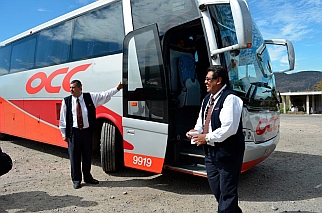
Our bus to Oaxaca.
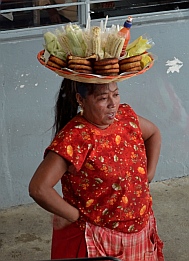
Snacks for sale at a bus stop.
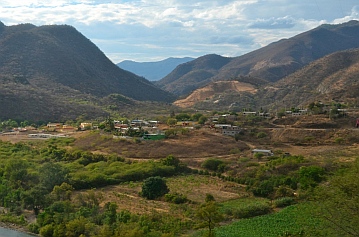
Mountains on the way to Oaxaca.
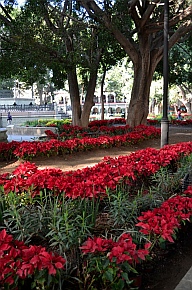
Poinsettias and tall trees in
Oaxaca's Zócalo.

Outdoor eateries surround the Zócalo.
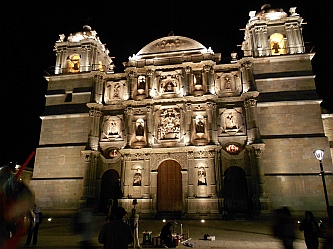
Santo Domingo Cathedral.
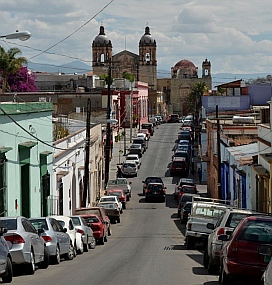
We walk down towards the historic district.
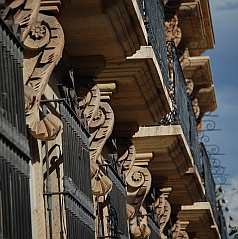
Oaxaca is loaded with charm.
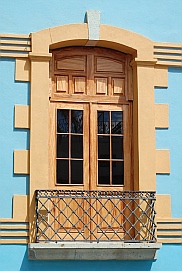
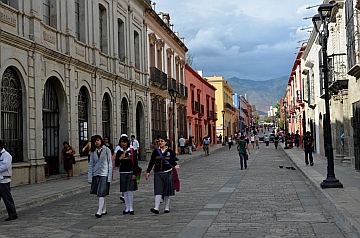
One long cobbled street is set aside for pedestrians only.
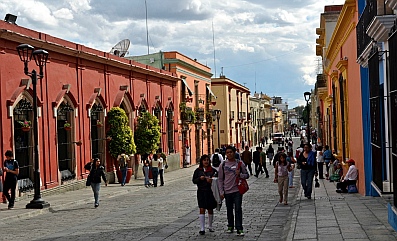
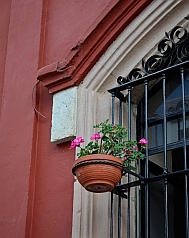
Flowers adorn many
windows.
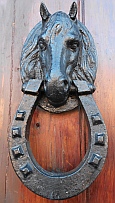
Door knocker.
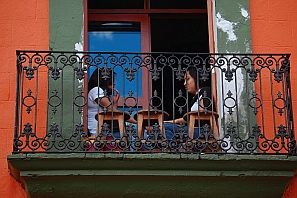
There are great places for a snack and a view
all over town.
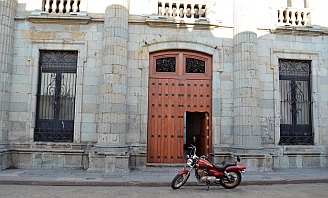
Many buildings have a door-within-a-door out front.
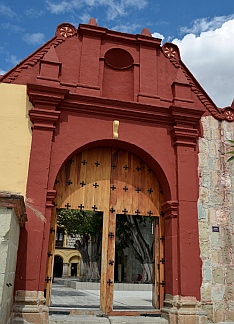
This church has two doors in its
gate.
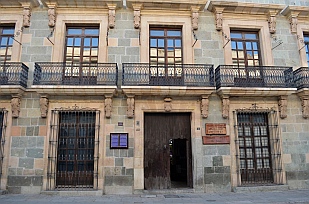
The front of the public library.

The courtyard inside the public library.
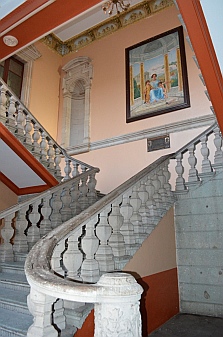
Fancy stairs from the courtyard to
the second story balcony in the
university courtyard.
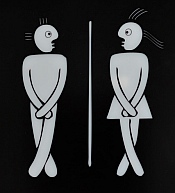
Self-explanatory in every
language.
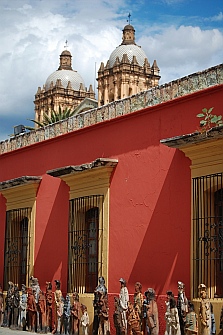
Clusters of strange sculptures of
people spill all over the sidewalks.

Sculptures of "migratorios" congregate by the cathedral.
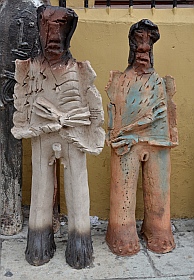
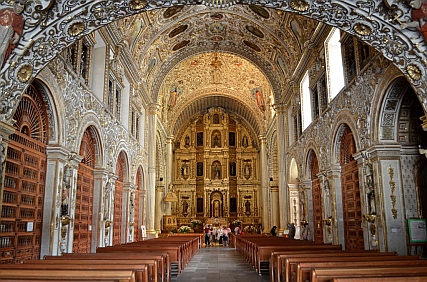
Inside the cathedral - gold, gold and more gold!!
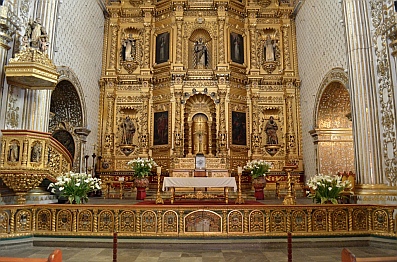
The overriding theme is gold.

Pulpit.

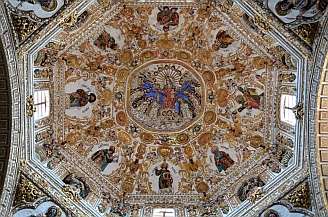
A portion of the ceiling.
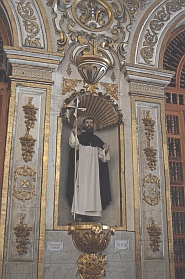
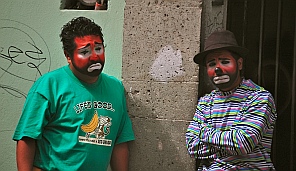
Street performers abound.

Uniformed schoolkids hang out by the cathedral after school.
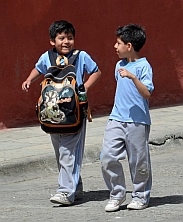
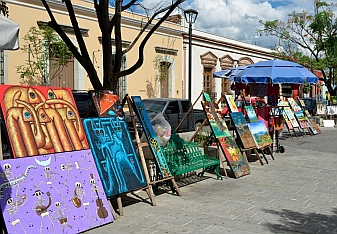
Paintings for sale on the sidewalks of the art district.
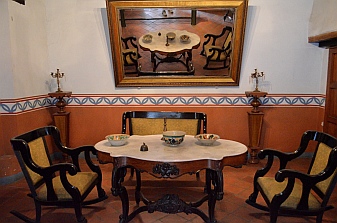
Home of former president Benito Juarez.
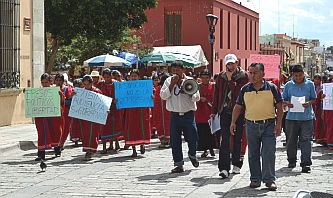
Protesters cruise past us carrying signs.
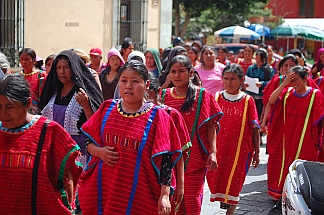
Triqui protesters.

Two tourists make a video of
themselves in front of the
cathedral.
Oaxaca, Mexico (1)
Mid-February, 2012 - We left the seaside life of Huatulco behind for a
few days to get a glimpse of the colonial mountain city of Oaxaca
(pronounced "Wahaka"). There are two ranges of mountains to cross,
and there are several ways to make the trek. A $12 ride in a small van
will take you on sickness-inducing switchbacks up treacherous single lane
mountain roads, but gets you there in six hours. A daytime $23 bus goes
around the worst mountain passes but makes a lot of stops, getting you
there in 10 hours. A $28 overnight bus makes the trip in 8 hours with just
one stop. Or you can fly for $100.
Preferring comfortable budget travel and
sleeping in a bed, we opted for the day
bus. This was a fun way to go with lots of
action. At one stop a lady with a basket of snacks on her head showed up at the bus and
started calling out her wares in a shrill voice. At another stop a security guard boarded the bus
and video-taped everyone's faces. At a military checkpoint the men were all herded off the bus
while the womenfolk were left on board. This seemed a little odd until we found out it was just
so the brawny guys could lift the heavy luggage out of the baggage compartment for inspection.
In the end they all re-boarded the bus carrying chips and drinks they'd gotten at a little roadside
stand. The womenfolk were happy about that! But the bus company didn't leave us hungry for
long. At lunch time the bus stopped for half an hour at a cute little roadside restaurant.
It was a long drive, but the views in
the mountains approaching Oaxaca
were quite nice. These mountains
are a major Mescal manufacturing
region, and many mountainsides
were a patchwork of agave cactus
fields.
We arrived in the early evening and,
after dropping off our bags at the
hotel, we dashed out to the Zócalo,
the main town square which is the
heart of the city. Huge trees
dominate this city park, and
poinsettias were planted thickly
around them.
The square is actually made up of two
squares adjoined at the corners, and all
the edges of these squares are lined with
outdoor eateries. As darkness fell the
place came alive.
Hundreds of
people were
everywhere,
walking, sitting,
eating, selling stuff,
buying stuff, talking
on the phone and necking.
You name it, it was
happening at the Zócalo.
Towering above it all, the
Santo Domingo Cathedral
lit up the night.
We stayed at the Hotel Casa del Sótano, a
charming little hotel built around a courtyard with a
pretty outdoor breakfast terrace. We drank our
morning coffee and fresh squeezed orange juice
looking out over the city as it woke up, and we
were utterly enchanted. This is a walking town if
there ever was one, and right after breakfast we
hoofed it straight down to the old town district.
Oaxaca oozes charm from every ornate balcony, wrought iron
gate and rooftop terrace. It is a city with a past and a soul.
Built in 1521 by the Spanish on an Aztec miitary site, the flavor
is both historic and hip at the same time.
We couldn't stop the cameras from clicking. Everywhere
we turned there was something begging to be framed
and remembered.
The streets are cobbled (one main artery is pedestrian
only) and the buildings are heavily embellished with
elaborate trim.
Flowers hung from the
balconies, and Mark was
fascinated by the crazy door
knockers on many of the
doors.
And there are a zillion places to get a bite to eat
with a view onto the city streets.
Many buildings have a very
large front door with a
smaller utility door cut into it.
The little door is the one you
use to get inside.
One of the churches has two utility doors cut
into its main front gate.
All kinds of things can reside behind these
imposing doors. Usually it is a courtyard. In
the public buildings we found the doors were
often open, and we wandered in and out of
quite a few. The city library has a lovely
courtyard inside.
One of the universities -- Universidad
Autónomo "Benito Juárez" de Oaxaca --
has a plain courtyard but a grand, curvy
staircase going to the second floor.
There are several universities in this city, so there are young people everywhere. It
is also a favorite international tourist destination, and we met folks from Austria,
Denmark and England during our stay. To satisfy these groups of people there are
enchanting little restaurants, coffee shops and bars everywhere. Just in case the
tourists visiting Cafe Brújulu don't speak Spanish, their bathroom signs need no
translation!
As we made our way over to the Santo Domingo Cathedral, we found little groups
of odd statues standing around in front of many of the shops. Hundreds of them
filled a huge area in front of the church and spilled over into the sidewalks all
around.
We later learned that Oaxacan artist Alejandro Santiago
created these sculptures called "2501 Migrants" to
represent the 2500 people (plus himself) from his
hometown of Teoculcuilco that have left town to seek a
better fortune elsewhere. He first placed the sculptures in
his hometown as a spiritual replacement of the people who
had left. Then he lined them up in the desert between
Mexico and the USA along the most common migration route.
Now they stand around the Oaxaca's beautiful cathedral plaza.
After wandering
among these
intriguing statues for
a while we went
inside the cathedral.
Wow! Every inch of
the interior is
trimmed in fancy
gold leaf designs.
Some 60,000 sheets
of 23.5 carat gold
leaf were used in its
construction, and the
walls and ceilings
sparkle with gold.
I couldn't help but wonder, as the sunlight
glinted off the baroque patterns, whether this
gold had once been the artwork of the
Zapotecs or Aztecs or other indigenous people,
melted down by the Spanish to
decorate the church. Or had it
been mined by the Spanish
nearby?
I asked several guides and the
consensus was that it came from
the local gold mines that had
originally perked Spain's interest
in Oaxaca and wasn't the result
of melted ancient treasures.
As it turns out, the Oaxaca area mountains are still rich with
gold, and the Canadian-owned mine Natividad is
busy extracting it today.
But the real treasure in Oaxaca is not the gold or
even the architecture but the funky spirit that
makes this city a fun place to be. Street
performers and artists strut their stuff on the
streets, and school kids hang out under the trees
by the cathedral.
There is an artisans district
where art of all kinds is for sale
on the sidewalks, along with
literary books in many languages
and hard-to-find music CD's.
These aren't the usual cheap
bootleg hawkers found in other
towns, but university types
selling off parts of their
collections for pocket change.
Wandering down a side street we bumped into the
boyhood home of Benito Juárez, Mexico's only
indigenous president (1858-1864). A pure Zapotec, he
is revered for education reforms that are still in effect
today and for spearheading the separation of church
and state in Mexico.
Being the capital of the state of Oaxaca
as well as a university town, politics play
an important role here. Strolling down
the street we suddenly saw a parade of
scarlet clad women marching towards us
carrying signs.
They were the Triqui indigenous people, and they were staging a sit-in in front
of the governor's building in an effort to gain support from the recently elected
governor for their cause, which, from what we could gather, involved land
disputes and violence in their hometown.
There was a vibrance and an energy
here in Oaxaca that made the Triqui
protests, the migrant statues and the
brutal history of the Spanish conquests all blend together as brilliant facets of humanity's
unstoppable ambition and its dramatic quest for happiness and prosperity.
This town is so photogenic that we saw tourists everywhere whipping out cameras to
capture snapshots to take home. One couple got particularly creative and set up a tripod
with a video camera in front of the cathedral. They pointed the camera at themselves with
the church in the background and talked for quite some time about how much their travels
meant to them and what great experiences they had had so far in Mexico, ending their
conversation with a "hello" to friends and family back home.
We sure were loving Oaxaca's action and color, and there was no need for us to leave
just yet.
Find Oaxaca on Mexico Maps.
